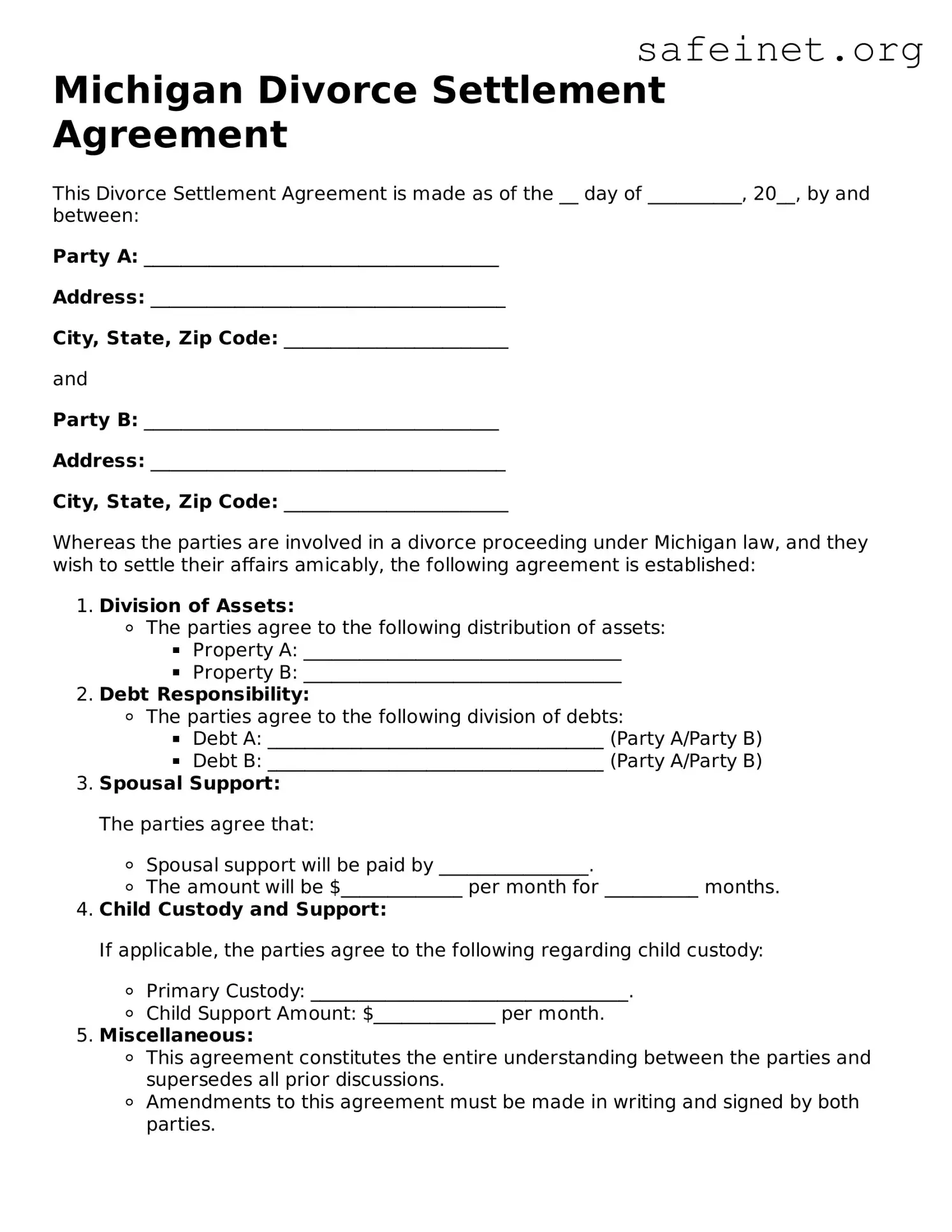What is the Michigan Divorce Settlement Agreement form?
The Michigan Divorce Settlement Agreement form is a legal document that outlines the terms and conditions agreed upon by both parties during a divorce. This form typically addresses issues such as property division, child custody, visitation rights, child support, and spousal support. It serves as a comprehensive summary of the agreements made and is submitted to the court for approval.
Why is a Divorce Settlement Agreement important?
This agreement is crucial because it helps to ensure that both parties have a clear understanding of their rights and responsibilities after the divorce is finalized. It can prevent future disputes by establishing clear expectations regarding financial matters, parenting arrangements, and the distribution of assets. Such clarity can ease the transition to post-divorce life for everyone involved.
Can I draft my own Divorce Settlement Agreement?
Yes, it is possible to create your own Divorce Settlement Agreement. However, it is advisable to seek professional guidance. An attorney can help ensure that the agreement complies with Michigan laws and adequately protects your interests. Using templates can sometimes lead to oversights that might impact your situation negatively later on.
What happens if my spouse and I cannot agree on the terms?
If both parties are unable to reach an agreement on the divorce terms, they may need to consider mediation or other dispute resolution methods. Mediation involves a neutral third party who helps facilitate discussions and offers solutions. If mediation fails, it may be necessary to proceed to court, where a judge will decide the terms of the divorce based on the evidence presented.
How do I submit the Divorce Settlement Agreement to the court?
To submit the Divorce Settlement Agreement to the court, you must file it along with other required documents. These documents may include the divorce complaint and any custody-related forms. It is essential to file the documents with the appropriate court and pay any associated fees. Always check with the court clerk for specific procedures related to your jurisdiction.
Can the Divorce Settlement Agreement be modified after signing?
Yes, the Divorce Settlement Agreement can be modified after it has been signed, but changes require a formal process. If both parties agree to the modifications, they will typically need to file a motion with the court to have the changes legally recognized. If only one party seeks a modification, it may be necessary to establish changed circumstances or demonstrate that the modification is in the best interest of involved children.
What if my spouse does not comply with the Agreement?
If one party does not comply with the Divorce Settlement Agreement, the other party can take legal action. This may involve filing a motion for enforcement with the court, which could lead to a hearing where the non-compliant party must explain their actions. In extreme cases, failure to comply could lead to contempt of court, potentially resulting in fines or other penalties.
Is legal representation necessary when filing the Divorce Settlement Agreement?
While legal representation is not strictly necessary, having an attorney can be beneficial. An attorney can provide guidance on legal rights, ensure that all necessary provisions are included in the agreement, and help navigate any complications that may arise. Particularly in contested divorces or cases involving children, legal assistance is recommended to protect your interests.
Where can I obtain the Michigan Divorce Settlement Agreement form?
The Michigan Divorce Settlement Agreement form can usually be found on the official Michigan state or local court websites. Additionally, many legal aid organizations may provide resources and templates for individuals seeking to create their own forms. Local law libraries may also have copies available for use.
